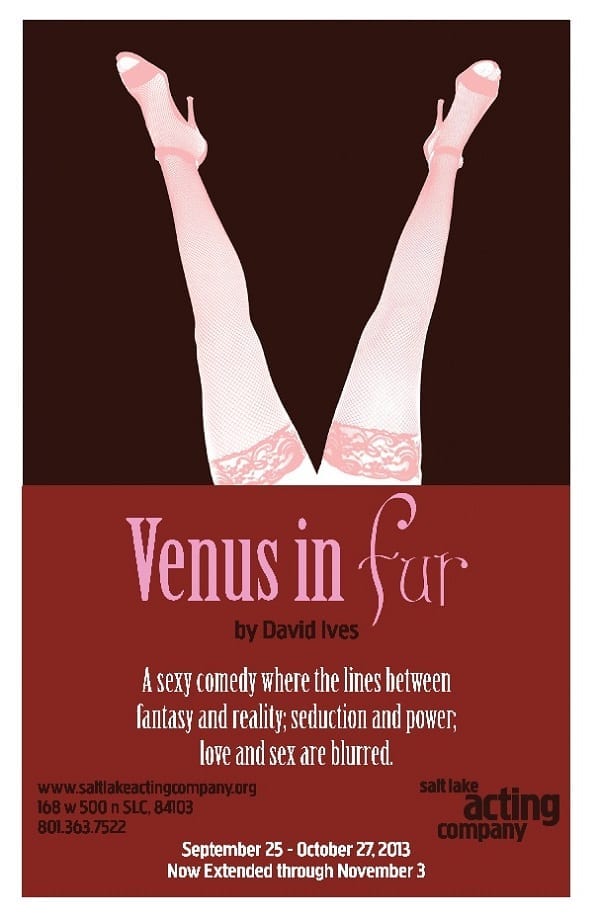SALT LAKE CITY — Venus in Fur is a play full of mysteries, as the viewer must try to discover the hidden desires of Thomas Novachek, a writer-director of a new play, and Vanda Jordan, an off-kilter actress who arrives late for her audition. The excitement in watching Venus in Fur is in not knowing exactly what the emotional and sexual stakes really are, and the ending is somewhat of a surprise as it doesn’t provide a clear resolution, but rather leaves it to the audience to draw their own conclusions based on their observations.

Playwright David Ives uses the fictional play-within-a-play construction to explore the nature of dominance and submission between men and women—and whether the sexes can ever be equal if they are in opposition. The story begins as Thomas has just concluded a round of unsuccessful auditions for his new play, an adaptation of the 1870 novel Venus in Furs, which inspired the term “masochism” and was a precursor of BDSM. As the play starts, Thomas is greatly irritated by Vanda’s late arrival and unprofessional and rather “ditsy” demeanor. She comes across as rather clueless about the play (she thinks that the play was about porn). However, Vanda reveals that she has memorized the entire play to perfection and shows astonishing insights into the novel and her character. Just as in the novel, the balance of power shifts as the actress establishes total dominance over the director. As the play progresses, what initially appeared to be a conventional theatre piece begins to morph into an abstract piece of absurdist theatre (reminiscent of other similar works such as Who’s Afraid of Virginia Wolf? or The Bald Soprano).
Ives’s writing was creative and engaging in this nontraditional form, as he packed in great humor through his believable and natural writing style. The fully dimensional characters were enhanced by the excellent direction of Tracy Callahan whose pacing kept the action compelling. Callahan also created interesting pictures so that the story was always clear. I liked how her blocking helped support the themes of dominance and submission by showing which character was in which role, with the “casting couch” maintaining the central focal point.
Marza Warsinske as Vanda Jordan is a truly gifted actress that gave a stunning performance as this bizarre, mysterious character who clearly was interested in more than getting the part. Warsinske showed great versatility as she seamlessly transitioned between playing the fictional role of Wanda von Dunajew and Vanda. Warinske’s performance felt dangerous because it seemed that at any moment Vanda could explode or reveal a deeper layer of herself. Standout moments included the transition into sex-driven Wanda who manipulated Thomas into taking on a submissive role.
Patrick Kintz as Thomas Novachek delivered a strong performance as the reserved, slightly stiff writer-director, which provided a nice contrast to the flighty and over-the-top Vanda. However, at times I felt that he was reacting for the audience or creating an artificial display of Thomas’s feelings, rather than staying fully engaged with Warsinske. During these times I was pulled out of the action of the play because Kintz’s reasons for reacting were not always clear. I also wanted a greater variety of choices as to reveal more layers and parts of his personality. He was successful in the more sensual moments where he allowed Thomas’s carnal nature to take over and lose all control as he fell under the spell of Vanda’s sexual dominance. One moment that didn’t work was when Thomas transitioned into Wanda von Dunajew; in this moment the sexual tension needed to be oozing and the passion so strong that Thomas is driven to irrational behavior as he became aroused. But the subdued performance from Klintz kept the climax of the play from being fully reached (no pun intended). I also did not believe Thomas’s outburst towards Vanda’s initial attempts of dominance and blatant disrespect. Kintz’s reaction was again too calm, which made the moment lose some of its jarring impact. Yet on the whole, he had good chemistry with Warsinske and successfully embraced the physicality and energy of his character.
The costuming (K. L. Alberts) helped reveal both character’s personalities and made clear when the actors were performing from Thomas’s script and when they were conversing in the modern day. The set design (Keven Myhre) also established the setting clearly, and the interesting lighting design (James M. Craig) and sound design (Josh Martin) helped to set the mood and visually enhance the action, such as each time Vanda switched the breakers a new energy was created through Craig’s lighting design; together these effects served key plot points and moments with lightning and thunder interrupting or supporting the dialogue onstage, which at first seemed to be coincidental in an eerie way, but by the end of the show (without revealing the ending) suggests that perhaps they were actually controlled by Vanda.
I would recommend Venus in Fur to the astute theatregoer that is prepared to think. This is not a casual or traditional piece of theater intended for the passive audience member. It deals openly with adult themes and language in an unsettling manner and does not fully resolve itself by the end making the message not fully clear. Rather, the audience members must draw upon their own experiences to create this message, in a “modern art” type fashion. Salt Lake Acting Company definitely succeeded in premiering this hot off Broadway contemporary comedy and Utah theatregoers should take advantage of this unique opportunity to see this acclaimed new work.
[box type=”shadow”]Venus in Fur plays Wednesdays through Saturdays at 7:30 PM and Sundays at 1 PM and 6 PM at Salt Lake Acting Company (168 W. 500 N., Salt Lake City). Tickets are $15-$35. For more information, visit saltlakeactingcompany.org.[/box]
